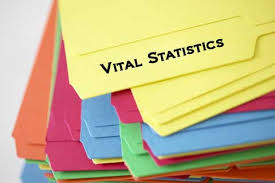Vital Statistics is defined as that branch of Biometry which deals with data and the laws of human mortality, morbidity and demography. The term vital statistics refers to the numerical data or the techniques used in the analysis of the data pertaining to vital events occurring in the given section of the population.
Sir Arthur Newsholme in his book The Elements of Vital Statistics defined Vital Statistics as “the whole study of mankind as affected by heredity or environment in so far as the results of this study can be arithmetically stated.” According to him “Vital Statistics forms perhaps the most important branch of Statistics as it deals with mankind in the aggregate. It is the science of numbers to the life history of communities and nations.”
According to Benjamin “Vital Statistics are conventional numerical records of marriages, births, sickness and deaths by which the health and growth of a community may be studied.”
Uses of Vital Statistics
- Study of Population Trend.
- The study of births (fertility) and deaths (mortality) gives us an idea of the population trend of any region, community or country.
If ‘Birth Rate > Death Rate’, there is an increasing trend.
If ‘Birth Rate < Death Rate’, there is a decreasing trend.
- In underdeveloped countries, the birth rate is fairly high but at the same time it is accompanied by high infant mortality rate showing thereby the lack of medical facilities, poor hygienic conditions, malnutrition and low standard of living.
- Use in Public Administration
- The study of population movement, i.e., population estimation, population projections and other allied studies together with birth and death statistics according to age and sex distributions provides any administration with fundamental tools which are indispensable for the overall planning and evaluation of economic and social development programmes.
- Mortality and natality statistics also provide guide spots for use by the researchers in medical and pharmaceutical profession.
- Use to Operating Agencies
- The facts and figures relating to births, deaths and marriages are of extreme importance to various official agencies for a variety of administrative purposes.
- Mortality statistics serve as a guide to the health authorities for sanitary improvements, improved medical facilities and public cleanliness.
- The data on the incidence of diseases, together with the number of deaths by age and nature of diseases are of paramount importance to health authorities in taking remedial action to prevent or control the spread of the disease.
- The vital records concerning all possible factors contributing to deaths in various ages are indispensable tool in numerous life insurance schemes.





6 Comments. Leave new
Good work!
Good efforts..
the topic is nice. Good job 🙂
nice
informative 🙂
nice…